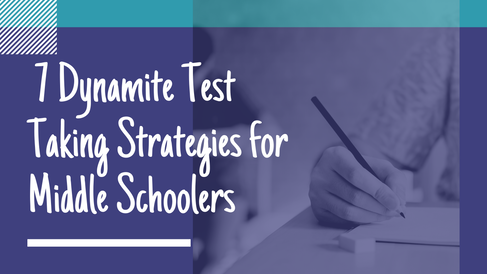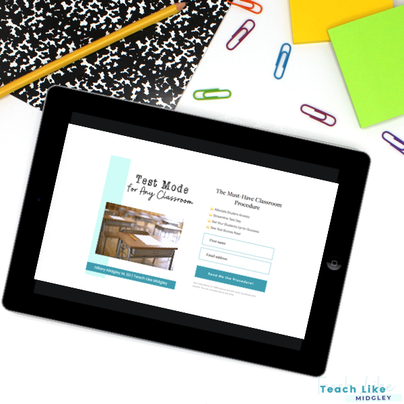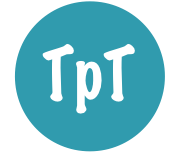7 Dynamite Test Taking
Strategies for Students
Learning new test taking strategies can really help a student excel academically.
Just like anything else, the ability to take a test – no matter what the subject area – is a skill in itself.
Yes, knowing the content inside and out will help you succeed on a test.
But sometimes, no matter how well you know the material, taking the test can be hard and downright stressful.
Why is that? Why is it that no matter how well a student may know the material, they may not do well on the test?
Just like anything else, the ability to take a test – no matter what the subject area – is a skill in itself.
Yes, knowing the content inside and out will help you succeed on a test.
But sometimes, no matter how well you know the material, taking the test can be hard and downright stressful.
Why is that? Why is it that no matter how well a student may know the material, they may not do well on the test?
One might answer that question by referencing the different learning styles. Or perhaps the student didn’t fully follow the instructions. Or even understand what the directions were asking them to do. Maybe there’s a lot of outside pressure to do well on the test. Or the student may be completely distracted by other events in their life to be able to focus.
As you can see, there are plenty of reasons why a student may not perform their best on a test.
As teachers, we have the opportunity to help students learn skills that will help them to focus on their tests, and even overcome many of these obstacles.
In this post, you’ll learn 7 dynamite test taking strategies that you can teach your middle schoolers.
Have a Test Day Routine
The best test taking strategy a student can learn, is a test day routine. As the teacher, you can only control what happens in your classroom. But you can also encourage students to extend their test day routine beyond that.
The routine can start the night before a test – a final practice quiz and review of key concepts and vocabulary before bed. Also be sure to pack up all materials needed for class on test day.
The morning of the test – students can review/recite information during breakfast or on their way to school.
Come to class on time with all required materials. When students arrive on time and prepared, they are immediately in a good place mentally to take their test.
To establish a test day routine in your classroom, be sure students know what to expect when they walk in the door. Be sure to check out my FREE Test Day Procedure to get you started on the right track.
The routine can start the night before a test – a final practice quiz and review of key concepts and vocabulary before bed. Also be sure to pack up all materials needed for class on test day.
The morning of the test – students can review/recite information during breakfast or on their way to school.
Come to class on time with all required materials. When students arrive on time and prepared, they are immediately in a good place mentally to take their test.
To establish a test day routine in your classroom, be sure students know what to expect when they walk in the door. Be sure to check out my FREE Test Day Procedure to get you started on the right track.
Learn About Test Anxiety
There are two types of test anxiety: situational anxiety and anticipatory anxiety.
Situational anxiety is where students suffer from anxiety during a test no matter how much they’ve studied.
Anticipatory anxiety is where students suffer from anxiety days before a test.
It’s important to note that a little bit of stress is normal. When students know that it’s normal, they can expect it and find it easier to deal with.
Forgetting about a test, not studying or arriving to class unprepared is not test anxiety. The anxiety clearly comes from not being prepared.
Identifying which type of anxiety a student suffers from can go a long way in helping them to learn strategies to overcome their anxiety.
Situational anxiety is where students suffer from anxiety during a test no matter how much they’ve studied.
Anticipatory anxiety is where students suffer from anxiety days before a test.
It’s important to note that a little bit of stress is normal. When students know that it’s normal, they can expect it and find it easier to deal with.
Forgetting about a test, not studying or arriving to class unprepared is not test anxiety. The anxiety clearly comes from not being prepared.
Identifying which type of anxiety a student suffers from can go a long way in helping them to learn strategies to overcome their anxiety.
Learn Strategies to Overcome Test Anxiety
While study skills definitely come more naturally to some people than others, we cannot assume that our students have knowledge of these skills.
Just like any other skill set, study skills must be taught to our students. In middle school is where we often first see a big need for this type of instruction.
There are strategies and skills to help students deal with test anxiety, but they must be taught. You can’t expect students to get past it, if they don’t have the skills they need to do so. And many times, all it takes is a few small strategies that can make all the difference for a student.
Just like any other skill set, study skills must be taught to our students. In middle school is where we often first see a big need for this type of instruction.
There are strategies and skills to help students deal with test anxiety, but they must be taught. You can’t expect students to get past it, if they don’t have the skills they need to do so. And many times, all it takes is a few small strategies that can make all the difference for a student.
Learn What Study Strategies Work Best
As teachers we often get frustrated because our students seem to not study for their tests and quizzes. But this frustration is misguided. We must first teach our students how to study before we can expect them to do it.
Since we know that different strategies work best for different types of learners, it’s important that we take the time to teach students different study strategies.
The best way to do this is to incorporate these study strategies into your classroom and daily lessons. While you will want to focus on different strategies for learning your specific content, we must also make sure we cover the strategies are a bit more general and can be used for any subject area.
You may be interested in checking out my FREE Study Strategies for Any Subject to get you started.
Since we know that different strategies work best for different types of learners, it’s important that we take the time to teach students different study strategies.
The best way to do this is to incorporate these study strategies into your classroom and daily lessons. While you will want to focus on different strategies for learning your specific content, we must also make sure we cover the strategies are a bit more general and can be used for any subject area.
You may be interested in checking out my FREE Study Strategies for Any Subject to get you started.
Schedule Time to Study
Study time isn’t going to happen if there’s no plan in place. Again, as teachers we can only control what takes place in our classroom. But that doesn’t mean we are powerless.
A week before the test, start talking about it with your students. What should they expect. What areas should they focus on for studying.
Spend the last 10 minutes of class working through a new study strategy. Show students how they can practice on their own. You can even make that study strategy part of their homework assignment.
The power of suggestion is just that – powerful. And it provides students with some direction. Your 6th graders need that direction. And they will be more likely to study, if they know what to do.
A week before the test, start talking about it with your students. What should they expect. What areas should they focus on for studying.
Spend the last 10 minutes of class working through a new study strategy. Show students how they can practice on their own. You can even make that study strategy part of their homework assignment.
The power of suggestion is just that – powerful. And it provides students with some direction. Your 6th graders need that direction. And they will be more likely to study, if they know what to do.
Encourage Students to Ask Questions
It really stinks to see a student get a question wrong simply because they didn’t fully understand what was being asked of them.
Encourage your students to ask questions about the directions on the test and about the test questions themselves.
A good strategy to make sure students know what to do for each part of the test, is to actually go through the directions with them. Pass out the tests, have students write their name, and then literally read out loud all of the directions on each page.
This gives students a chance to see the entire test, hear all of the directions, and get their mind in gear. It’s a very small task that can make a big impact on student success.
If your 6th graders are like mine, they will probably hesitate to raise their hand for a question during a test. You can help them overcome this by frequently roaming the room and making yourself available if someone appears to be stuck.
Encourage your students to ask questions about the directions on the test and about the test questions themselves.
A good strategy to make sure students know what to do for each part of the test, is to actually go through the directions with them. Pass out the tests, have students write their name, and then literally read out loud all of the directions on each page.
This gives students a chance to see the entire test, hear all of the directions, and get their mind in gear. It’s a very small task that can make a big impact on student success.
If your 6th graders are like mine, they will probably hesitate to raise their hand for a question during a test. You can help them overcome this by frequently roaming the room and making yourself available if someone appears to be stuck.
Set Students Up for Success
So, if you haven’t downloaded my FREE Test Day Procedure, you’re going to want to go do that right now.
The best way you can help your students prepare for test day is to make sure they know what to expect. Unexpected surprises will not help students overcome their anxiety.
Just to be clear – I am not telling you to teach to the test. Absolutely not. But I am telling you to prepare your students by clearly identifying your expectations. On review day, I will often stand at the front of the class with a copy of the test in my hand. I will then flip through it and tell students what’s on it – 5 short answer questions, 3 questions with a map, 4 questions with a timeline, and so on. You can prepare students and provide them with a study guide, without giving away your test.
The best way you can help your students prepare for test day is to make sure they know what to expect. Unexpected surprises will not help students overcome their anxiety.
Just to be clear – I am not telling you to teach to the test. Absolutely not. But I am telling you to prepare your students by clearly identifying your expectations. On review day, I will often stand at the front of the class with a copy of the test in my hand. I will then flip through it and tell students what’s on it – 5 short answer questions, 3 questions with a map, 4 questions with a timeline, and so on. You can prepare students and provide them with a study guide, without giving away your test.
Ready to Roll Materials
Now you know exactly what you need to teach your students to help them with their test taking strategies.
But if you are looking for more guidance, I’ve got just want you need. Taking Tests is an entire chapter in my 9 Week Study Skills Course Curriculum for 6th graders.
You can now get the Chapter 6 Taking Tests separately from the entire course, and you can also get a flipped classroom video lesson with digital materials on Taking Tests too.
But if you are looking for more guidance, I’ve got just want you need. Taking Tests is an entire chapter in my 9 Week Study Skills Course Curriculum for 6th graders.
You can now get the Chapter 6 Taking Tests separately from the entire course, and you can also get a flipped classroom video lesson with digital materials on Taking Tests too.
You May Also Like...
Let's Connect...

Welcome! I'm Hillary Midgley, a veteran 6th grade teacher.
I create educational materials and develop curriculum for other teachers. I specialize in teaching students how to learn through my Study Skills Curriculum. I have established fundamental classroom systems and structures for teachers to help them streamline their classroom. And my passion is teaching ancient history through engaging activities with foundations in academic skills. Here you will find resources on all of these topics and more. Learn more about me here.
|











